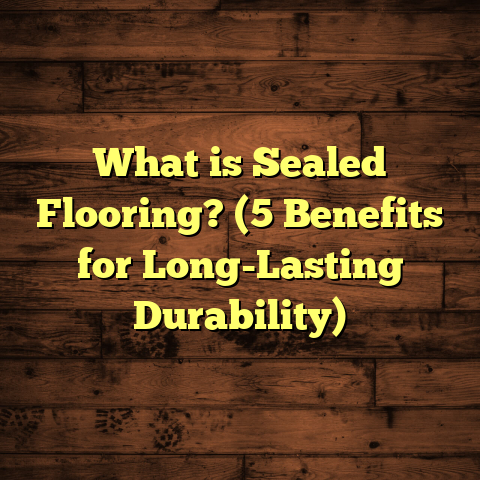What is Wide Plank Wood Flooring? (5 Benefits for Your Home)
I still remember the first time I walked into a home and saw those wide plank wood floors stretching across the room. It wasn’t just a floor—it was a statement, a feeling, an experience. I was hooked. The way those wide boards told a story through their grain and knots was unlike anything I’d seen with narrow strip floors. Since then, wide plank wood flooring has become one of the most rewarding projects I get to install and talk about. If you’re wondering what this style is all about and whether it’s right for your home, I’m here to take you on a detailed journey through its many layers.
What Is Wide Plank Wood Flooring?
When it comes down to it, wide plank wood flooring means exactly what it sounds like: wooden boards that are wider than the standard flooring strips we often see. Typical hardwood floors come in planks that are roughly 2¼ to 3¼ inches wide. Wide plank flooring starts at about 5 inches across and can go all the way up to 12 inches or even wider in some custom installations.
This width difference might seem small at first glance, but it completely changes the look and feel of a space. Wider planks reduce the number of seams between boards, creating a more seamless and natural flow across your floors. It’s like comparing a patchwork quilt made of tiny pieces to one made out of large panels—the bigger surfaces allow the wood’s natural beauty to shine.
Wide plank flooring comes in two main types:
- Solid hardwood wide planks: These are milled from a single piece of wood, typically ¾ inch thick or more. They can be sanded and refinished multiple times over their lifespan.
- Engineered wide planks: These have a real wood veneer layer on top bonded to plywood or high-density fiberboard underneath. They offer more stability in humid or varying climates but have fewer refinishing options depending on the veneer thickness.
The species available for wide plank flooring are just as diverse as traditional hardwood floors: oak, maple, walnut, cherry, hickory, and many others. Each species brings its own grain patterns, hardness, and color palette.
Why Are Wide Planks So Popular Now?
Wide plank floors were once reserved mostly for older homes or high-end custom builds because sourcing large boards is harder and they cost more. But over the last decade, they’ve surged in popularity thanks to changing design trends favoring natural materials and open spaces.
I hear clients say things like:
“I want something authentic but modern.”
“I want my floor to be a feature, not just something underfoot.”
Wide plank wood flooring fits those desires perfectly.
My Journey with Wide Plank Wood Flooring
I’ve been installing floors professionally for over 15 years now. Early on, I mostly worked with traditional strip hardwood floors because they were easier to source and install. But after my first wide plank project—a Victorian fixer-upper with original 7-inch oak floors—I realized the difference.
The owners wanted to preserve as much of the home’s original charm as possible while updating it for modern living. We carefully restored the existing wide planks where possible and filled gaps with matching new boards where needed. The effect was stunning: large boards with visible grain running uninterrupted through rooms gave the house a cohesive, airy feel that just wasn’t possible with narrow strips.
Since then, I’ve installed wide plank floors in everything from rustic cabins to sleek urban condos. Each project teaches me more about how versatile and resilient these floors can be.
Five Benefits of Wide Plank Wood Flooring That Make It Worth Considering
Let me break down the reasons why I always suggest wide plank wood flooring to clients who want something special. These benefits are based on my hands-on experience, industry data, and feedback from homeowners.
1. Dramatic Visual Impact That Opens Up Your Space
One thing I noticed immediately about wide plank flooring is how it changes a room’s perception of size. With fewer seams breaking up the floor, your eyes can follow the long lines of the wood grain across the room. This creates a sense of openness and flow.
In fact, research by the National Wood Flooring Association (NWFA) supports this observation. Their studies show that wider boards tend to make rooms feel larger because they reduce visual clutter on the floor.
I remember installing 6-inch white oak planks in a small cottage kitchen. The owner told me afterward that it felt like the room “expanded” even though the floor area hadn’t changed at all. That’s the power of wide planks.
The fewer seams also mean less grout lines or filling material showing through (if you’re using engineered floors), which creates a more uniform surface that’s easier on the eyes.
2. Showcases Wood’s Natural Beauty More Authentically
This one is close to my heart because I’m always fascinated by how nature creates unique patterns in wood. Wide planks let you see more of those patterns in one piece compared to narrow strips, which chop up the grain into smaller sections.
When you walk on wide planks, you can spot knots, sapwood streaks, color variations, and mineral deposits that give each board its own character.
These features make your floor feel organic—almost like a piece of art underfoot.
Historic homes often featured wide plank floors because large old-growth trees were plentiful back then. Choosing wide planks today connects your home with that heritage and craftsmanship spirit.
3. Durability That Stands the Test of Time
Wide plank floors tend to be thicker than narrow strip floors—especially if solid hardwood—which means they can be sanded and refinished multiple times over decades.
Think about it: fewer seams also means fewer places where moisture or dirt can creep in and damage the floorboards or subfloor beneath.
From my personal projects, I’ve seen century-old homes whose original wide plank oak or pine floors are still going strong after several refinishes.
That’s not just nostalgia talking—that’s real value for your investment.
4. Style Flexibility for Every Home Design
Wide plank wood flooring isn’t just for rustic or traditional homes; it’s surprisingly versatile and can fit into many styles:
- Rustic or farmhouse: Use distressed wide planks with knots and hand-scraped finishes.
- Modern: Smooth matte finishes on walnut or maple with minimal grain patterns.
- Transitional: Natural oak with soft finishes blends old and new.
- Industrial: Wide planks paired with steel accents and concrete walls.
I once installed 8-inch walnut engineered planks in a downtown loft with exposed brick and steel beams. The warmth of the wood balanced the coldness of industrial elements perfectly.
You can also choose different installation patterns like straight lay, diagonal, or herringbone with wide planks to further customize your look.
5. Adds Real Value When Selling Your Home
People love hardwood floors when shopping for houses—it’s one of those features that frequently tops buyer wish lists for good reason.
According to Remodeling Magazine’s Cost vs. Value report, hardwood floors can recoup about 70% or more of their installation costs at resale.
Wide plank floors are less common than standard strip floors, so they give your home an edge in uniqueness and perceived quality.
One client told me after upgrading their entire main floor to wide planks that their real estate agent highlighted it as a major selling point during an open house—and they sold within weeks at full asking price!
Breaking Down the Technical Details: What You Need to Know Before Buying
If you’re seriously thinking about wide plank wood flooring, here are some technical details based on my experience that will help you plan better:
Widths and Thicknesses
- Wide plank widths typically range from 5 inches up to 12 inches or more.
- Planks wider than 7 inches begin to show more prominent wood movement due to humidity changes.
- Solid hardwood planks are usually about ¾ inch thick, allowing multiple sanding cycles.
- Engineered wood thickness varies from ⅜ inch (with thin veneer) up to ¾ inch (thicker veneer layers).
Wood Species Choices
Species affect durability, color, grain pattern, and cost:
| Species | Hardness (Janka Rating) | Color Range | Grain Characteristics |
|---|---|---|---|
| White Oak | ~1360 | Light tan to medium | Straight grain, tight texture |
| Red Oak | ~1290 | Reddish hues | Coarse grain |
| Walnut | ~1010 | Rich dark brown | Straight with occasional curls |
| Hickory | ~1820 | Light to medium brown | Bold grain patterns |
| Maple | ~1450 | Creamy white | Fine grain |
| Cherry | ~950 | Reddish pink | Smooth grain |
Installation Methods
- Nail-down: Traditional method for solid hardwood on wood subfloors.
- Glue-down: Common over concrete slabs using engineered planks.
- Floating: Click-lock engineered planks installed over underlayment.
Each method has pros and cons depending on your subfloor type and moisture levels.
Cost Breakdown
- Material costs range from $8–$15+ per square foot depending on wood species and grade.
- Installation labor varies from $3–$8 per square foot depending on complexity.
- Additional costs may include sanding/refinishing ($2–$4 per sq ft), moldings, subfloor prep.
My rule of thumb is to budget about $12–$20 per square foot total for quality wide plank hardwood installation projects.
How Does Wide Plank Flooring Perform Over Time?
One question I always get asked is: “How well do these wider boards hold up?” The answer depends on several factors:
- Wood species hardness: Harder woods like hickory resist dents better.
- Finish type: Polyurethane finishes add protection but may scratch; oil finishes offer natural look but need more upkeep.
- Home environment: Humidity control reduces expansion/contraction stress.
- Maintenance: Regular cleaning and prompt repair of scratches keep floors looking new longer.
In my experience helping clients maintain their floors over years:
- Wide planks show scratches more noticeably but sanding them down restores beauty.
- Boards tend to expand/contract more visibly than narrow strips but this doesn’t cause damage if installed properly with acclimation time.
- Properly finished wide plank floors can last over 50 years in residential settings without full replacement.
Case Study: Restoring Wide Plank Floors in a Historic Home
One project I’m particularly proud of involved restoring original wide plank heart pine floors in an 1800s farmhouse that had suffered water damage over decades.
The planks were 9 inches wide—much larger than most new flooring options available today—and had deep patina from age.
Here’s what we did:
- Removed damaged boards carefully for salvage.
- Sourced reclaimed heart pine boards from regional suppliers to match width and grain.
- Sanded all flooring in multiple passes using fine grit sandpaper.
- Applied custom blend stain followed by durable satin polyurethane finish.
- Sealed gaps with flexible wood filler matching stain color for seamless appearance.
The results were spectacular: the floor looked almost like new but kept its antique charm intact. The homeowners told me it was the feature they loved most about their renovated farmhouse.
Tips for Choosing Wide Plank Wood Flooring That Fits Your Home
If you’re considering this flooring style for your own place, here are some practical tips from my years on job sites:
- Measure carefully: Larger widths mean fewer boards but require precise layout planning.
- Consider your climate: If you live somewhere humid or with drastic seasonal changes, engineered wide plank may be better.
- Pick species based on use: High traffic? Go harder woods like oak or hickory.
- Think finish early: Matte finishes hide scratches better; gloss shows off grain but reveals wear faster.
- Budget for extras: Wide plank installation often requires more skilled labor due to handling larger heavy boards carefully.
And don’t forget to ask your installer about acclimation time—they’ll need to let boards adjust to indoor humidity before laying them down.
Maintenance Advice for Long-lasting Floors
Keeping your wide plank flooring beautiful over decades is easier than you think if you follow these steps:
- Sweep or vacuum regularly using soft attachments.
- Clean spills promptly using damp cloths—avoid soaking floors.
- Use protective pads under furniture legs.
- Refinish every 7–10 years depending on wear.
- Avoid harsh chemicals; use cleaners designed specifically for hardwood.
If you want my personal favorite product recommendations or DIY maintenance hacks, just ask—I’m always happy to share!
How Wide Plank Flooring Compares With Other Flooring Types
It helps to put wide plank wood flooring side-by-side against other popular options so you get perspective:
| Feature | Wide Plank Wood | Narrow Strip Hardwood | Laminate Flooring | Vinyl Flooring |
|---|---|---|---|---|
| Visual Impact | High – natural beauty visible across large areas | Moderate | Low – looks artificial | Low – synthetic look |
| Durability | Very durable with refinishing potential | Durable | Durable but no refinishing | Durable but scratches easily |
| Cost | Moderate-high | Moderate | Low | Low |
| Installation | Skilled labor needed | Skilled labor needed | DIY-friendly | DIY-friendly |
| Maintenance | Requires care & refinishing | Requires care | Easy | Easy |
| Resale Value | High | High | Low | Low |
Wide plank wood flooring excels when quality, aesthetics, and longevity matter most in your home investment.
Final Thoughts About Wide Plank Wood Flooring
Wide plank wood flooring isn’t just another flooring option—it’s an experience underfoot. It combines natural beauty with practicality in ways few materials can match. Whether you want warmth in a rustic cabin or sleekness in a modern condo, these broad boards offer versatility along with timeless charm.
Thinking about cost? Yes, it’s an investment but one that pays off with durability, style impact, and increased home value down the line.
I encourage you to imagine walking barefoot across wide boards that tell a story beneath your feet—each knot and streak connecting you to nature’s craftsmanship.
If you want help figuring out if wide plank wood flooring fits your home’s style and budget or need guidance on installation details and maintenance tips—let’s chat! I’m here to share everything I’ve learned over thousands of square feet of flooring projects.





